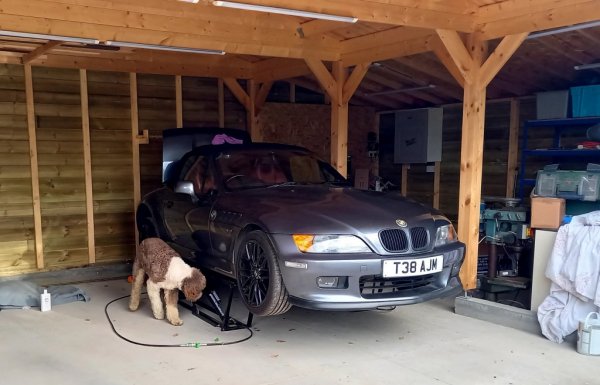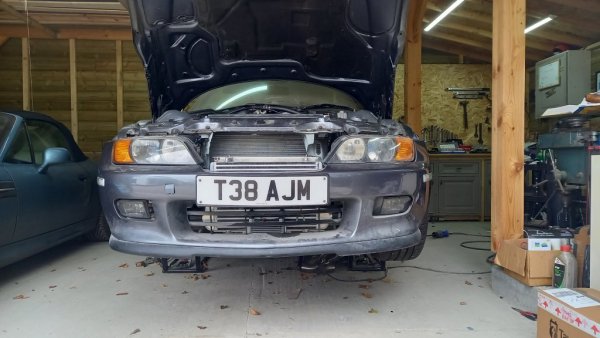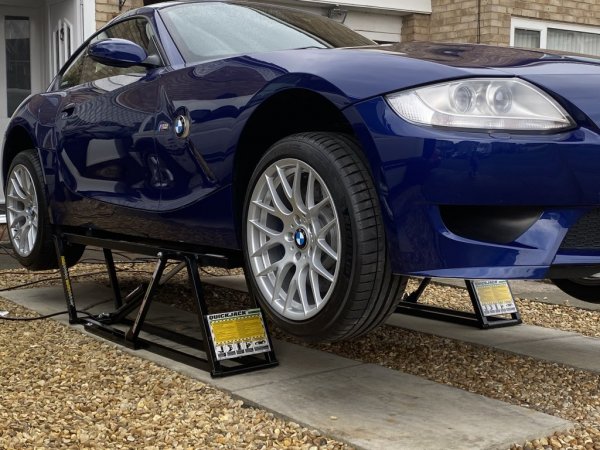I've got both.
The Quick Jack is quicker

and easier to use. It's very easy to align with lifting points. Access is easy as it is only just over a foot wide. The self-sealing hydraulic couplings are tight and difficult to connect / disconnect. you will need to fill it with ATF before you can use it. The 12v pump draws a lot of current, so you need good jump leads to connect the pump to the battery of a running car. The lift height is adequate for most jobs. Although I've not tried removing a gearbox, I have taken off an exhaust. Only the sills are inaccessible when the ramps are in use. It fits in my van without much struggle and is easily portable.
The tilting ramp is the weapon of choice for a project that is going to take more than a few days. Unless you have rigged up a way to drive over the ramp, you will need a space beside the car that is wider than the ramp as the ramp can only come in from the side. Balancing the car is a bit of a faff, but once you know the balance point, it is the same every time you use the ramp. I have the ramp positioned so that it is just touching the front jacking points and I load the boot with 30kg. The car is too heavy to tilt from fully arse-down to nose-down (it would also be pretty scary

), or vice-versa, but it doesn't take long to lower the car until the tilt is reduced and you can change the tilt, then raise the vehicle. There is a hand crank supplied that allows you to raise and lower the car, but you won't want to use it - you will want to use the optional drill. It is not your ordinary drill, but a high torque drill (ECD IP-310). It is not cordless, which is a PITA. I tried my cordless impact torque gun, but it was too noisy. I don't think there is a cordless drill available that could do the job. I was instructed to raise the car from one side and to lower it from the other. This may be because the drill doesn't have a reverse. The drill's torque is such that you could break your wrist if you are no careful. I rest the body on the ground so the twist is into the ground and it won't spin in the air. The ramp does have locking pins, but they are to prevent further tipping of the vehicle. The screw thread is sufficient to stop the ramp lowering under its own weight. Accessiblity under the centre of the car is limited by the frame, but access under the front and rear is excellent - sometimes you need to lower the ramp to be able to comfortably work on stuff - too high to lie, too low to sit. I have to remove the bulkhead to fit it in my van and I would say that it is only just portable - I use a small trolley to move it.
I use the tilt ramp if I know that I am going to be working on the car for a while. I think I would use the quick ramp for a gearbox, but everything else would be the tilt.
If I just want to spend an hour or two taking wheels off / bleeding the brakes - quick jack.
If I'm doing a big service and will take a week or more - tilt ramp.
Big jobs (excluding gearbox off) - tilt ramp.
Jobs away from home - quick jack.








 and easier to use. It's very easy to align with lifting points. Access is easy as it is only just over a foot wide. The self-sealing hydraulic couplings are tight and difficult to connect / disconnect. you will need to fill it with ATF before you can use it. The 12v pump draws a lot of current, so you need good jump leads to connect the pump to the battery of a running car. The lift height is adequate for most jobs. Although I've not tried removing a gearbox, I have taken off an exhaust. Only the sills are inaccessible when the ramps are in use. It fits in my van without much struggle and is easily portable.
and easier to use. It's very easy to align with lifting points. Access is easy as it is only just over a foot wide. The self-sealing hydraulic couplings are tight and difficult to connect / disconnect. you will need to fill it with ATF before you can use it. The 12v pump draws a lot of current, so you need good jump leads to connect the pump to the battery of a running car. The lift height is adequate for most jobs. Although I've not tried removing a gearbox, I have taken off an exhaust. Only the sills are inaccessible when the ramps are in use. It fits in my van without much struggle and is easily portable. ), or vice-versa, but it doesn't take long to lower the car until the tilt is reduced and you can change the tilt, then raise the vehicle. There is a hand crank supplied that allows you to raise and lower the car, but you won't want to use it - you will want to use the optional drill. It is not your ordinary drill, but a high torque drill (ECD IP-310). It is not cordless, which is a PITA. I tried my cordless impact torque gun, but it was too noisy. I don't think there is a cordless drill available that could do the job. I was instructed to raise the car from one side and to lower it from the other. This may be because the drill doesn't have a reverse. The drill's torque is such that you could break your wrist if you are no careful. I rest the body on the ground so the twist is into the ground and it won't spin in the air. The ramp does have locking pins, but they are to prevent further tipping of the vehicle. The screw thread is sufficient to stop the ramp lowering under its own weight. Accessiblity under the centre of the car is limited by the frame, but access under the front and rear is excellent - sometimes you need to lower the ramp to be able to comfortably work on stuff - too high to lie, too low to sit. I have to remove the bulkhead to fit it in my van and I would say that it is only just portable - I use a small trolley to move it.
), or vice-versa, but it doesn't take long to lower the car until the tilt is reduced and you can change the tilt, then raise the vehicle. There is a hand crank supplied that allows you to raise and lower the car, but you won't want to use it - you will want to use the optional drill. It is not your ordinary drill, but a high torque drill (ECD IP-310). It is not cordless, which is a PITA. I tried my cordless impact torque gun, but it was too noisy. I don't think there is a cordless drill available that could do the job. I was instructed to raise the car from one side and to lower it from the other. This may be because the drill doesn't have a reverse. The drill's torque is such that you could break your wrist if you are no careful. I rest the body on the ground so the twist is into the ground and it won't spin in the air. The ramp does have locking pins, but they are to prevent further tipping of the vehicle. The screw thread is sufficient to stop the ramp lowering under its own weight. Accessiblity under the centre of the car is limited by the frame, but access under the front and rear is excellent - sometimes you need to lower the ramp to be able to comfortably work on stuff - too high to lie, too low to sit. I have to remove the bulkhead to fit it in my van and I would say that it is only just portable - I use a small trolley to move it.